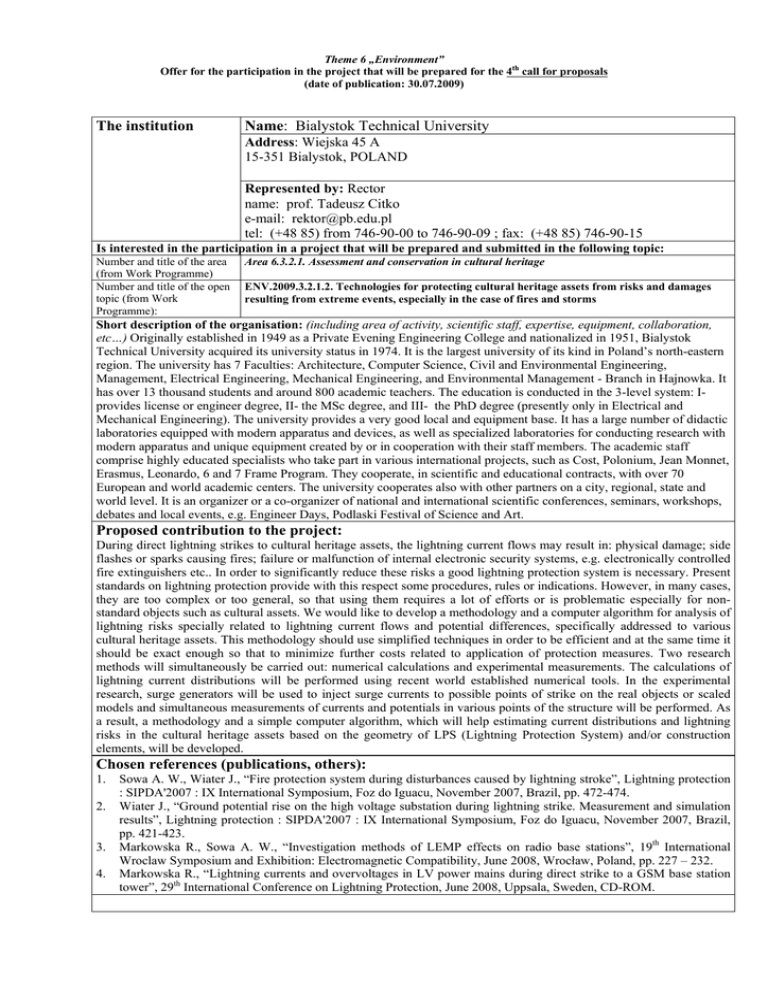Name: Bialystok Technical University The institution Proposed
advertisement

Theme 6 „Environment” Offer for the participation in the project that will be prepared for the 4th call for proposals (date of publication: 30.07.2009) The institution Name: Bialystok Technical University Address: Wiejska 45 A 15-351 Bialystok, POLAND Represented by: Rector name: prof. Tadeusz Citko e-mail: rektor@pb.edu.pl tel: (+48 85) from 746-90-00 to 746-90-09 ; fax: (+48 85) 746-90-15 Is interested in the participation in a project that will be prepared and submitted in the following topic: Number and title of the area (from Work Programme) Number and title of the open topic (from Work Programme): Area 6.3.2.1. Assessment and conservation in cultural heritage ENV.2009.3.2.1.2. Technologies for protecting cultural heritage assets from risks and damages resulting from extreme events, especially in the case of fires and storms Short description of the organisation: (including area of activity, scientific staff, expertise, equipment, collaboration, etc…) Originally established in 1949 as a Private Evening Engineering College and nationalized in 1951, Bialystok Technical University acquired its university status in 1974. It is the largest university of its kind in Poland’s north-eastern region. The university has 7 Faculties: Architecture, Computer Science, Civil and Environmental Engineering, Management, Electrical Engineering, Mechanical Engineering, and Environmental Management - Branch in Hajnowka. It has over 13 thousand students and around 800 academic teachers. The education is conducted in the 3-level system: Iprovides license or engineer degree, II- the MSc degree, and III- the PhD degree (presently only in Electrical and Mechanical Engineering). The university provides a very good local and equipment base. It has a large number of didactic laboratories equipped with modern apparatus and devices, as well as specialized laboratories for conducting research with modern apparatus and unique equipment created by or in cooperation with their staff members. The academic staff comprise highly educated specialists who take part in various international projects, such as Cost, Polonium, Jean Monnet, Erasmus, Leonardo, 6 and 7 Frame Program. They cooperate, in scientific and educational contracts, with over 70 European and world academic centers. The university cooperates also with other partners on a city, regional, state and world level. It is an organizer or a co-organizer of national and international scientific conferences, seminars, workshops, debates and local events, e.g. Engineer Days, Podlaski Festival of Science and Art. Proposed contribution to the project: During direct lightning strikes to cultural heritage assets, the lightning current flows may result in: physical damage; side flashes or sparks causing fires; failure or malfunction of internal electronic security systems, e.g. electronically controlled fire extinguishers etc.. In order to significantly reduce these risks a good lightning protection system is necessary. Present standards on lightning protection provide with this respect some procedures, rules or indications. However, in many cases, they are too complex or too general, so that using them requires a lot of efforts or is problematic especially for nonstandard objects such as cultural assets. We would like to develop a methodology and a computer algorithm for analysis of lightning risks specially related to lightning current flows and potential differences, specifically addressed to various cultural heritage assets. This methodology should use simplified techniques in order to be efficient and at the same time it should be exact enough so that to minimize further costs related to application of protection measures. Two research methods will simultaneously be carried out: numerical calculations and experimental measurements. The calculations of lightning current distributions will be performed using recent world established numerical tools. In the experimental research, surge generators will be used to inject surge currents to possible points of strike on the real objects or scaled models and simultaneous measurements of currents and potentials in various points of the structure will be performed. As a result, a methodology and a simple computer algorithm, which will help estimating current distributions and lightning risks in the cultural heritage assets based on the geometry of LPS (Lightning Protection System) and/or construction elements, will be developed. Chosen references (publications, others): 1. 2. 3. 4. Sowa A. W., Wiater J., “Fire protection system during disturbances caused by lightning stroke”, Lightning protection : SIPDA'2007 : IX International Symposium, Foz do Iguacu, November 2007, Brazil, pp. 472-474. Wiater J., “Ground potential rise on the high voltage substation during lightning strike. Measurement and simulation results”, Lightning protection : SIPDA'2007 : IX International Symposium, Foz do Iguacu, November 2007, Brazil, pp. 421-423. Markowska R., Sowa A. W., “Investigation methods of LEMP effects on radio base stations”, 19th International Wroclaw Symposium and Exhibition: Electromagnetic Compatibility, June 2008, Wrocław, Poland, pp. 227 – 232. Markowska R., “Lightning currents and overvoltages in LV power mains during direct strike to a GSM base station tower”, 29th International Conference on Lightning Protection, June 2008, Uppsala, Sweden, CD-ROM.



